Greek Yogurt: nutritional value, composition, benefits
Greek yogurt is a unique fermented dairy product, a favorite among Mediterranean inhabitants. About its composition, nutritional value, and use in cooking - next in our article.

Greek Yogurt: What it is
Greek yogurt is a fermented dairy product with a high dry solid content, obtained by fermenting milk with pure lactic acid bacteria cultures. Thanks to a special production technology, the yogurt has a thick, creamy texture with an excellent cream note.
Traditionally, Greek yogurt was prepared with sheep's milk, and the main difference from other fermented milk drinks is that after fermentation, it needed to be filtered to become thicker. Since the acidification of sheep's milk occurred differently than cow's milk, it was necessary to strain it under higher pressure. Sheep's milk is fattier and thicker, so the finished product was more concentrated – it was not possible to drink it.
According to legend, the production technology of this unusual product was born thanks to the forgetfulness of the Greeks, who left a jar of milk in a warm place. This is how Greek yogurt emerged, whose consistency resembles fresh cheese and cottage cheese. In each region of Greece, the fermented dairy product is prepared in its own way: in some places, cow's milk is boiled, thus increasing the concentration of dry solids, in others, sheep's or goat's milk is traditionally used and aged in cellars. What is immutable is that it is always fresh milk, without additives and unnecessary processing. Therefore, such a natural product is preserved for no more than 2-3 days.
In its homeland, Greece, yogurt is used not only as an independent dish but also as a dessert with honey, fruits, and nuts. And it is also the basis for preparing the traditional appetizer sauce Tzatziki, and the Greeks guarantee that you can eat everything with it.

How Greek yogurt differs from regular yogurt
Any yogurt, both regular and Greek, is made by fermenting milk using live bacteria cultures. The only difference is that Greek yogurt is strained to remove whey, resulting in a thicker consistency. Whey is rich in lactose, the natural sugar present in milk. Removing the liquid makes Greek yogurt thicker and gives it a creamy taste. Usually, before consumption, it is additionally placed in a strainer or gauze bag, so that the excess liquid drains into a separate container under its own weight. Regular yogurt, after fermentation, can be consumed immediately or placed in the refrigerator for a few hours.
Read also: Yogurt. Everything you wanted to know about yogurt
Both fermented dairy products are superfoods in the area of nutrition:
- they contain calcium and protein in their composition;
- they have probiotic properties;
- their bacteria contribute to the normalization of digestion;
- unsweetened dishes based on them can be used in diets.
But Greek yogurt has several nutritional advantages over regular yogurt. Being a product with a higher concentration of dry solids, it contains more calcium, protein, and other beneficial substances compared to unfiltered yogurt. It also has less sugar and carbohydrates, as part of the lactose present in all dairy products is removed along with the whey, and the rest is converted into lactic acid. Standard yogurt has up to 3% protein, while Greek yogurt can reach 10-15% protein per unit mass. It should be noted that these properties are characteristic of strained Greek yogurt. If the yogurt is not strained, the amount of beneficial microelements will be the same as that of the regular product.
The production of Greek yogurt requires 2-3 times more milk than for regular yogurt. But by preparing it at home, you can regulate the density of the finished product and the amount of whey to be removed.

Composition of Greek yogurt
In percentage terms, the nutrients in Greek yogurt are distributed as follows: 35% protein, no more than 45% fat, and only 20% carbohydrates.
This fermented dairy product is rich in sodium, magnesium, potassium, riboflavin, iodine, pantothenic acid, and contains 3% of the daily allowance of vitamin A (retinol) and 10% of calcium. Beneficial saturated fats and animal cholesterol, present in a small amount in yogurt, are necessary in small doses to maintain the health of the cardiovascular system.
In the diet of an average person, salt intake is often exceeded, and the prolonged accumulation of sodium salts causes disturbances in lymphatic flow and negatively affects the health of the cardiovascular system. In this case, the body can retain excess fluid, which can lead to edema and the depletion of calcium reserves. Therefore, it is very important to maintain the balance between the level of potassium and sodium – and Greek yogurt can help you maintain the correct proportions of microelements and gradually reduce salt consumption.
Yogurt, as a fermentation product, also contains less lactose than whole milk, and can be consumed by people with partial lactose intolerance.
But how to be sure that Greek yogurt contains the necessary nutrients? All beneficial properties of the product are inherent only to fresh, natural yogurt without additives. Some manufacturers, bypassing the straining process, add thickeners to achieve a thick consistency. Carefully read the composition and expiration date of the supermarket product. The yogurt should not contain dyes, preservatives, or thickeners. A product with corn starch, pectin, or powdered milk will not harm your body, but it also will not bring many benefits.
In the composition of the supermarket product, there should be nothing other than:
- normalized pasteurized milk;
- bacterial culture.
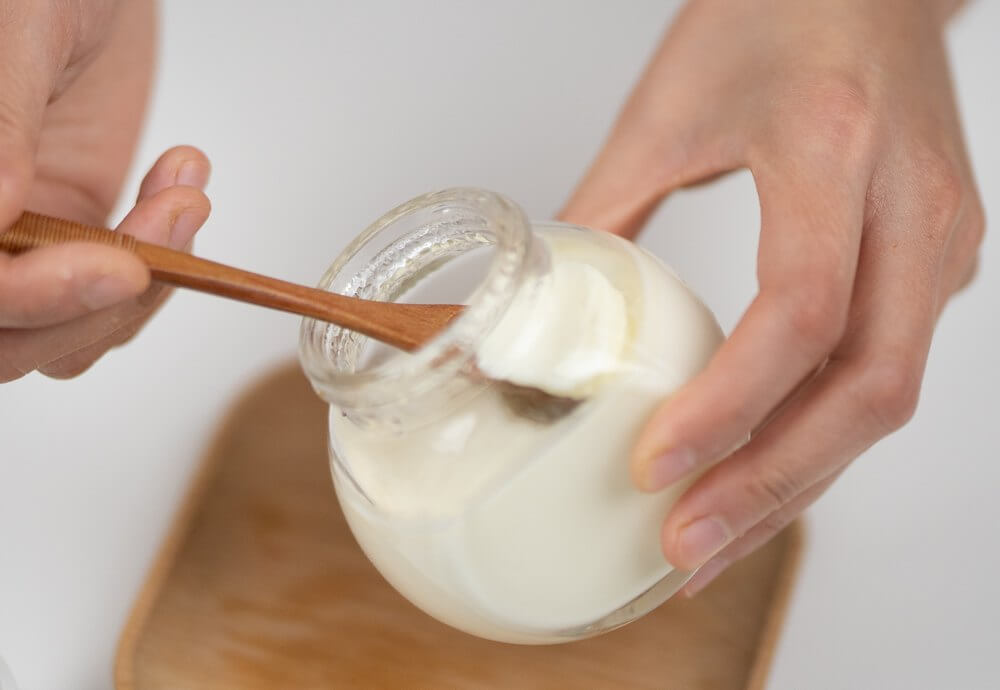
The percentage of fats in the supermarket product is within 2-4 grams, protein - up to 5 grams per 100 grams of product. These low nutrient indicators are justified by the fact that the low-calorie industrial product is generally made with skim milk using thickeners. This reduces its calorie content, but along with it, its nutritional value. If the yogurt has additives in the form of sugar, jam, or honey – this only increases the calories, but does not add benefits.
The homemade product, freshly prepared and strained, will contain more calcium, protein, and saturated fats, but its indicators depend on the amount of liquid released. To be sure of the quality and benefits of yogurt, we recommend preparing it at home with the help of the bacterial culture "Greek Yogurt VIVO". It contains the necessary dose of live microorganisms to ferment the yogurt directly in your kitchen. You will need homemade or supermarket milk, dry starter culture, and 15 minutes of time to heat the milk and create favorable temperature conditions for the life of the microorganisms. While they are in the package, they are sleeping, and the humid and warm environment wakes them up and promotes their multiplication, resulting in fresh, natural yogurt, without stabilizers or other harmful additives, when a stable comfortable temperature is maintained. Then, it only remains to strain the resulting mass through a fine strainer or a gauze folded in several layers. You can also use reusable straining bags, if you plan to continuously prepare fermented dairy products.
Greek Yogurt: nutritional value (calories)
Natural strained Greek yogurt will be fattier and more caloric than the unfiltered product. Due to the draining of a certain amount of whey, part of the carbohydrates will be eliminated with it, but the proteins and fats will remain in the dry part of the yogurt. Therefore, the nutritional value of the finished dish will be different. It depends on:
- the fat content of the milk you use for fermentation;
- the amount of yogurt remaining after straining.
What are the benefits of Greek yogurt
The beneficial bacteria and minerals in the composition of Greek yogurt:
- positively influence the immune system;
- provide the body with necessary nutrients;
- suppress the development of pathogenic microflora;
- promote better absorption of food;
- normalize the work of the stomach and intestines.
Greek yogurt is rich in amino acids, which proteins are made of, and proteins are building blocks for muscle tissue regeneration. According to technology, the liquid part of the fermented product is filtered, and all the protein remains in the dry part. That's why Greek yogurt is more satiating, contributes to muscle mass gain, and tissue recovery. If you play sports, a glass of this product after training will replenish the body with 20 grams of easily digestible protein. The consumption of this amount of protein immediately after training maximizes the speed of muscle tissue recovery. And people who consume enough protein in their daily diet generally eat less after a protein-rich meal and have more stable weight loss indicators. Add a banana or some berries for a complete post-workout snack.

Greek yogurt contributes to weight loss and can be used in the diet of people following a low-calorie diet. A serving of yogurt as one of the snacks will replenish the body with beneficial microelements, including calcium, which contributes to accelerating metabolism. For maximum effect, we recommend consuming the fermented dairy product in combination with fibrous carbohydrates (vegetables, fruits, and berries) and healthy fats (fish, nuts, seeds, avocado) without additional sweeteners.

Calcium is also an indispensable microelement for bone formation, especially important for children, women, and the elderly. Systematic consumption of unsweetened Greek yogurt with probiotic bacteria contributes to reducing the risk of osteoporosis in the elderly and increases bone density. The product also contains vitamin D, which contributes to calcium absorption. It should be noted that due to the high protein content, the introduction of Greek yogurt into children's diets is recommended from three years of age, to avoid overloading the kidneys.
Read also: Homemade fermented dairy products for children from 2 years old
Calcium also affects the production of cortisol in the body. Increased levels of the hormone cortisol can contribute to fat accumulation, preventing weight loss. By including calcium-rich Greek yogurt in your diet, you can partially restrict fat production in the body.
Greek yogurt contains iodine, which is important for the proper functioning of the thyroid gland. For people with weight problems, increasing the level of iodine in the diet increases the activity of the thyroid gland, which, in turn, increases the metabolism of hormones that contribute to weight loss.
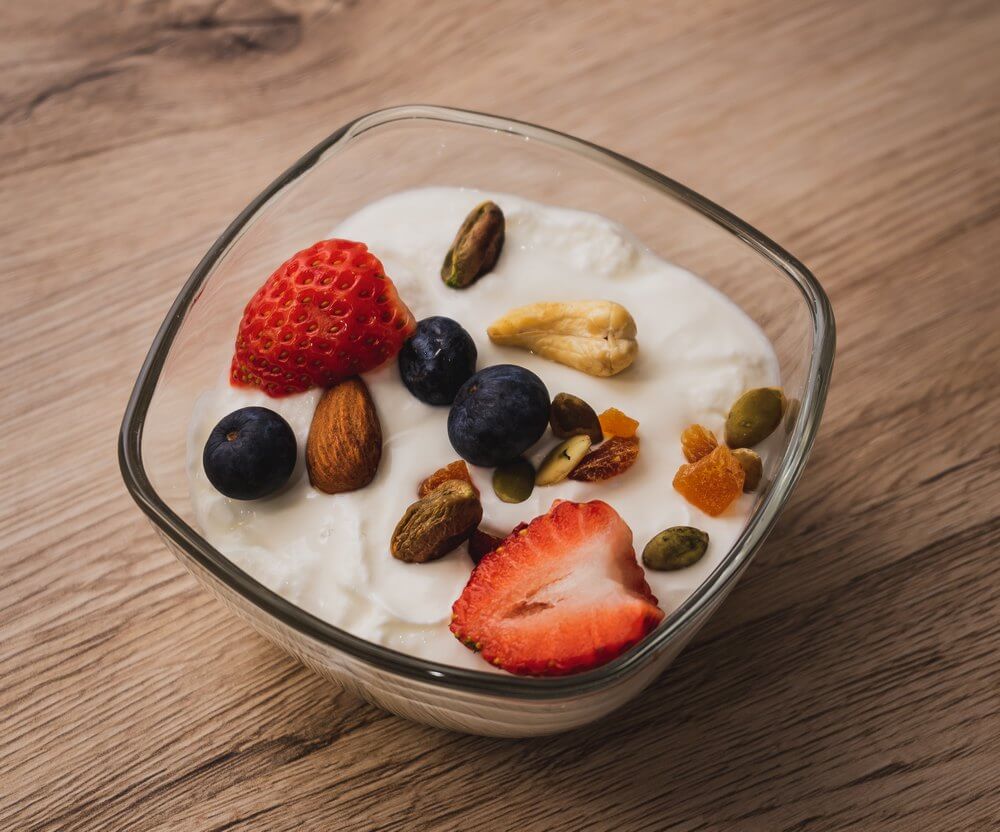
Serotonin – the happiness hormone – only 10-20% is synthesized in the brain, the remainder – in the intestine. The consumption of live probiotic bacteria, contained in the homemade fermented dairy product, positively affects mental health thanks to the close interconnection between the brain and the production of serotonin and dopamine neurotransmitters in the intestine. Daily consumption of 100 grams of probiotic Greek yogurt will help reduce the level of stress and anxiety.
Read also: How to strengthen immunity?
Regular consumption of Greek yogurt also positively affects carbohydrate metabolism and stabilizes blood glucose levels. This contributes to reducing the risk of type 2 diabetes, due to improved cellular sensitivity to insulin and reduced inflammation.
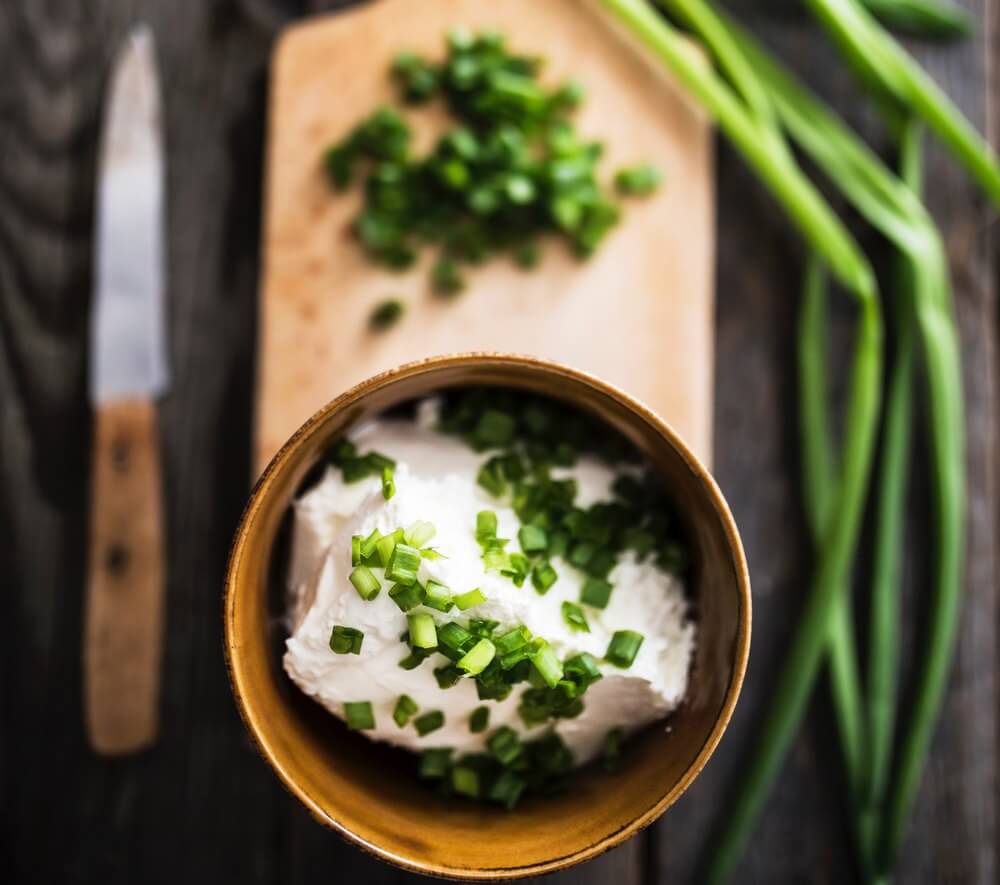
What can be prepared with Greek yogurt
Yogurt is an excellent base for preparing various sauces. Unsweetened Greek yogurt can easily replace mayonnaise in the daily diet, making the dish less caloric and healthier. It can also be used as a complete nutritious snack – just add your favorite fresh fruits, dried fruits, or nuts for maximum benefits. Next, we will tell you what to prepare and eat Greek yogurt with, which will complement the flavor of both desserts and savory dishes.
Tzatziki Sauce
Tzatziki is a basic and simple Greek sauce, served with meat, fish, spicy dishes, or simply with bread.
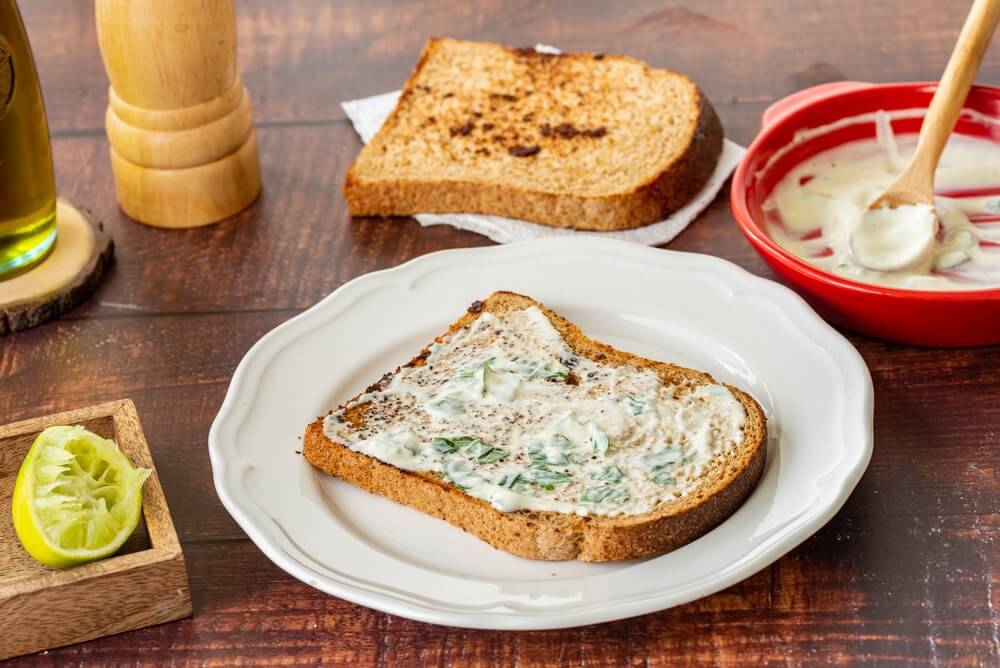
You will need:
- 200 grams of Greek yogurt;
- 2 sprigs of dill;
- olive oil;
- olives;
- salt;
- spicy marinated pepper;
- a few cloves of garlic.
How to prepare:
- The base ingredient – Greek yogurt – add to a separate bowl.
- Peel the cucumber and grate on a coarse grater. Squeeze and get rid of excess moisture. Add to the yogurt.
- First, crush the garlic cloves with a knife, then finely chop them. For a natural and not spicy flavor, one clove or even half will suffice. If the flavor does not seem rich enough, add more.
- Remove the stems from the dill, finely chop the rest, and combine all the ingredients.
- To serve, place a few spoons of the sauce on a serving plate, smooth it out, and make some depressions with the edge of a knife, imitating waves. On top, place a few olives and drizzle with a spoon of olive oil. For those who like it spicier, add the marinated pepper.
- The sauce should be served chilled, but not cold, so that the incredible aroma of the fresh products it is made from does not disappear.
You can watch the step-by-step video recipe for preparing the most popular Greek sauce, Tzatziki, on our Youtube channel.
Read also: Tzatziki Sauce (link)
Greek Yogurt, Cucumber, and Mint Sauce
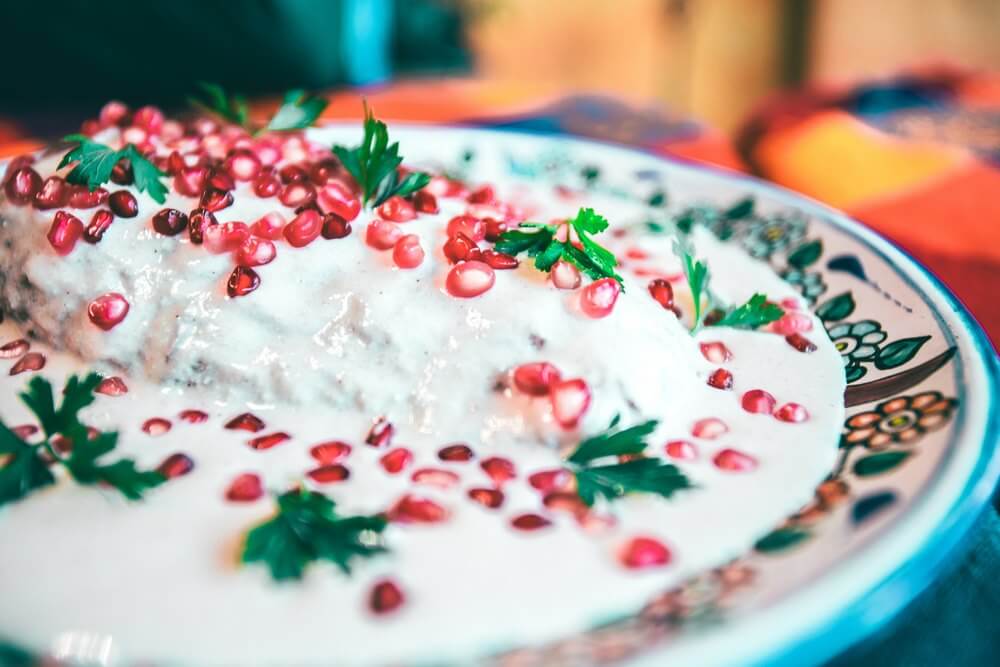
You will need:
- Greek yogurt;
- cucumber;
- mint;
- salt.
How to prepare:
- Peel the cucumber and grate on a fine grater. This will allow you to obtain a uniform flavor consistency. Place the cucumber in a strainer, salt it – the salt will cause the release of juice, which you need to get rid of. Stir and squeeze the pulp with a kitchen spatula. Thus, the cucumber will get a more concentrated flavor.
- Place the yogurt in a bowl, add the cucumber mass, stir.
- Crush the mint leaves between your fingers and finely chop, add to the bowl.
- Place in a sauceboat, decorate with a mint leaf or fresh pomegranate.
Yogurt Cake
The cake is prepared with normal ingredients without flour and yeast. It turns out very fluffy and delicate.

You will need:
- 4 chicken eggs;
- 350 grams of Greek yogurt;
- 3 tablespoons of corn starch;
- 3 tablespoons of sugar;
- 1 teaspoon of baking powder;
- zest of half a lemon;
- confectioner's sugar for dusting.
How to prepare:
- Remove the eggs from the refrigerator in advance, so they are at room temperature. Wash them in running water, remove the shell, and separate the egg white and yolk into different bowls. Make sure the utensils are clean and dry, otherwise the batter may not turn out.
- First, combine the egg yolks with three tablespoons of sugar. Stir for 5-7 minutes with a whisk, no need to beat. You should get a uniform consistency, so that the sugar dissolves completely.
- Wash the lemon and grate the yellow peel on a fine grater, but make sure that the white pulp does not fall in – it will give bitterness. Add to the mixed egg yolks.
- Add a teaspoon of baking powder and three tablespoons of starch. Mix well until homogeneous, so there are no lumps in the batter.
- Add the yogurt, mix too.
- Beat the egg whites into stiff peaks for 15-20 minutes, using a mixer. Start beating at low speed, gradually increasing the speed.
- Add the ready egg whites to the batter and gently mix with a spoon or kitchen spatula. Combine the ingredients very carefully so that the batter does not lose its fluffiness.
- Heat the oven to 170 degrees. Line a round baking pan 16-18 centimeters in diameter with parchment paper and grease with butter. Pour the batter and bake for 30-40 minutes.
- Observe the color of the "lid": as soon as it starts to brown, the cake can be turned off and left to rest for another 5-10 minutes.
- Carefully remove the paper and serve dusted with confectioner's sugar.
Strawberry Ice Cream with Greek Yogurt
The favorite treat of children and adults, which you can prepare yourself. And you won't need complicated preparations: normal ingredients and a little free time. Furthermore, while maintaining the usual sweetness, the ice cream will not be as fatty and caloric due to the light Greek yogurt.

You will need:
- 500 grams of Greek yogurt;
- 250 grams of strawberries;
- 120 grams of condensed milk;
- 1 tablespoon of honey;
- 0.5 teaspoon of vanilla extract.
How to prepare:
- In a bowl, mix the Greek yogurt with the condensed milk, honey, and vanilla extract. Use a whisk.
- Wash the strawberries, dry them, and remove the stems. Blend into a puree with a blender or pass through a strainer. Add to the remaining ingredients.
- Combine all ingredients with a whisk into a homogeneous mass, cover and take to the freezer.
- After an hour and a half, remove and stir with a whisk to break the ice crystals. Repeat this step 2-3 more times every 1.5 hours.
- Before serving, leave at room temperature for 10-15 minutes, then form balls and serve at the table.
Greek yogurt is a balanced and healthy product that will help you maintain correct body proportions, bone and nervous system health, establish stable digestion, and increase muscle mass. Now you know what the benefits of consuming Greek yogurt are, what its difference is from regular yogurt, and what to eat it with to bring maximum benefits and nutrients to the body.
Images taken from sources: pixabay.com, pexels.com.
Find the right VIVO product for you
- Strengthens the immune system
- Decreases risks of catching a cold
- Has an excellent taste and thick texture






